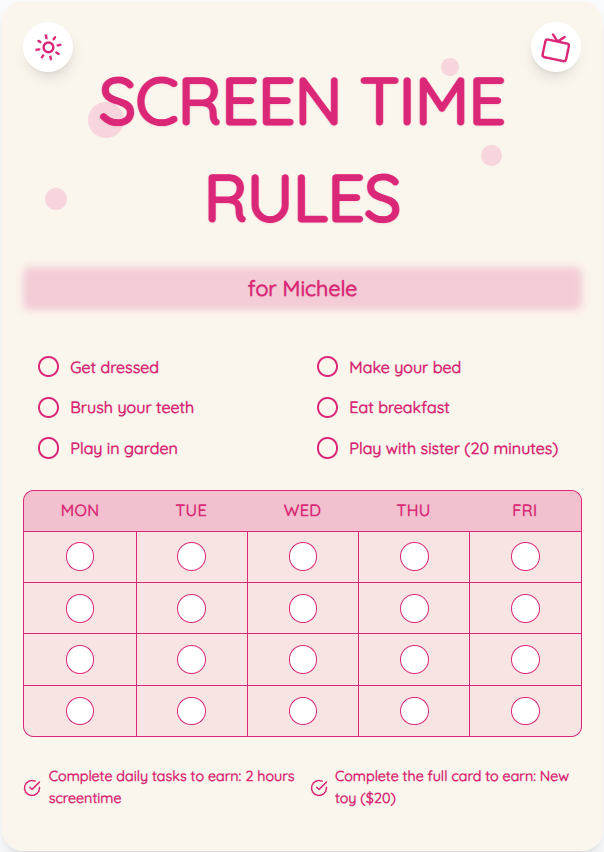Who Screen Time Limit: A Parent's Guide to Managing Screen Time for Children
As a parent, you may wonder who sets the screen time limit for your child. This guide provides actionable advice and practical tips for parents of children aged 2-12 to effectively manage screen time. By implementing these strategies, you can foster healthy child development and promote family harmony.
See What Your Screen Time Chart Will Look Like
Here's an example of a beautiful, customizable screen time rules chart you can create for your family

Understanding Screen Time Guidelines
Before setting screen time limits, it's crucial to understand the recommended guidelines for children's screen time based on their age. The American Academy of Pediatrics suggests limiting screen time to 1 hour per day for children aged 2-5 and promoting quality content for older children. By being aware of these guidelines, parents can make informed decisions.
Creating a Screen Time Schedule
Establishing a consistent screen time schedule helps children know when they can engage with screens and when they need to focus on other activities. Consider using a screen time chart generator like ScreenTimeRules.com to create a visual schedule that outlines designated screen time periods and non-screen time activities.
Put These Tips Into Action
Create a custom chart to implement these strategies with your child
Setting Clear Boundaries and Rules
Communicate clear screen time rules to your child, such as no screens during meal times or before bedtime. Consistency is key in enforcing these boundaries. Encourage alternative activities like outdoor play, reading, or creative projects to balance screen time with other enriching experiences.
Monitoring and Adjusting Screen Time Limits
Regularly monitor your child's screen time usage and be willing to adjust limits based on their behavior and well-being. Use parental control tools to track screen time and set automatic limits when necessary. Encourage open communication with your child about the importance of healthy screen time habits.
Practical Tips for Success
- Create a designated screen-free zone in your home, such as the dining area or bedrooms.
- Engage in screen time activities together as a family to monitor content and promote bonding.
- Encourage physical activity breaks between screen sessions to reduce sedentary behavior.
- Model healthy screen time habits by limiting your own screen use when around your child.
Frequently Asked Questions
How can I handle resistance from my child when implementing screen time limits?
Acknowledge your child's feelings but remain firm on the established rules. Offer alternative activities and positive reinforcement for complying with the limits.
Is it okay to use screen time charts for older children as well?
Yes, visual schedules can benefit children of all ages by providing structure and promoting self-regulation. Adapt the charts to suit your child's developmental stage.
What are the potential risks of excessive screen time for children?
Excessive screen time can lead to issues such as sleep disturbances, reduced physical activity, and lower academic performance. Setting limits is crucial for mitigating these risks.
By implementing these practical tips and strategies, parents can effectively manage screen time for their children while promoting healthy development and family harmony. Explore the benefits of using a screen time chart generator like ScreenTimeRules.com to simplify the process. Start creating a balanced screen time routine today!
Ready to Transform Your Family's Screen Time?
Join thousands of parents who have successfully managed screen time with our customizable charts.
